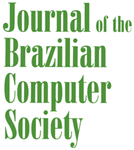Letter from the Editor-in-Chief
We are very pleased to announce that from this issue the Journal of the Brazilian Computer Society (JCBS) will be published four times a year (March, June, September and December).
In this edition we publish an invited paper by Jayme Luiz Szwarcfiter, who is the recipient of the 2005 Brazilian Computer Society Scientific Merit Award. The work is written jointly with Dourado and Protti. It is a survey on computational aspects of the Helly Property, with the focus on complexity. In 1923, Eduard Helly published his famous article on convex sets, which originated the so called Helly Property. Basically, if a family of subsets of a finite set U satisfies the condition that every intersecting subfamily of it contains a common element of U, then the family is said to be Helly. Helly families play a central role in some areas of mathematics, as combinatorial geometry, and it has applications in computer science, in areas as semantics, data bases and algorithms. The authors have described several NP-hardness results, as well as polynomial time algorithms, considering different families of subsets. Some generalizations of the Helly Property were also considered in the paper.
The second paper, by Feris, Raskar, Tan and Turk, was chosen as one of the best Computer Graphics papers of the 2004 Brazilian Symposium on Computer Graphics and Image Processing (SIBGRAPI04). It discusses the problem on reducing specularities in digital images by the use of multi-flash photography. The proposed method applies a Poisson equation on the gradient field of images captured with light sources positioned in different places, followed by a mating process combining the maximum composite of all images.
The third paper, by Chavez, Garcia, Kulesza, SantAnna and Lucena was chosen as the best paper of the 2005 Brazilian Symposium on Software Engineering (SBES05). It presents crosscutting interfaces as a conceptual tool for taming the complexity of heterogeneous aspects from early to detailed design. Crosscutting interfaces modularize disjoint subsets of enhancements provided by an heterogeneous aspect, where each subset affects homogeneously one or more modules. A conceptual framework for crosscutting interfaces is provided, with a set of definitions and fundamental properties. Two largescale case studies illustrate the usefulness of crosscutting interfaces at the architectural and detailed design stages. The examples are expressed in aSideML, an aspect-oriented modeling language that supports the explicit definition of crosscutting interfaces, and AOGA, a notation that extends aSideML to handle architecture-level aspects.
The next two papers have been submitted to JBCS. The fourth paper by Araujo, Silva and Todesco introduces 3D media adaptation, which due to its complexity has received less attention than multimedia adaptation. A framework is proposed that can be integrated to the MPEG4 standard to provide adaptation of 3D multiuser virtual environment, which can be accessed from heterogeneous devices with different capabilities. The integration of the framework to the MPEG-4 standard favors the creation of complex 3D applications with high degree of interaction. It also makes easier to build these applications for heterogeneous devices since MPEG-4 is aimed at small mobile devices and narrowband networks such as some existing wireless networks.
The last paper by Vergilio, Maldonado and Jino addresses the problem of infeasible paths in the context of data flow based criteria. In general, there is no algorithm to determine the feasibility of a path and this fact constitutes a bottleneck to the complete automation of software testing. The paper reports results of experiments considering three main approaches: identification, classification, and prediction of infeasible paths. Implementation aspects of mechanisms and facilities to deal with infeasibility are also presented. In addition to, these aspects are addressed in the scope of integration and object-oriented testing. The presented results and ideas contribute to reduce the effort, cost and time to apply structural testing criteria.
Last but not least, our thanks to the many anonymous reviewers that dedicated their time to the Journal of the Brazilian Computer Society and to the program committee of SIBGRAPI04 and SBES05.
Jaelson F. B. Castro
Publication Dates
-
Publication in this collection
24 May 2010 -
Date of issue
June 2006

